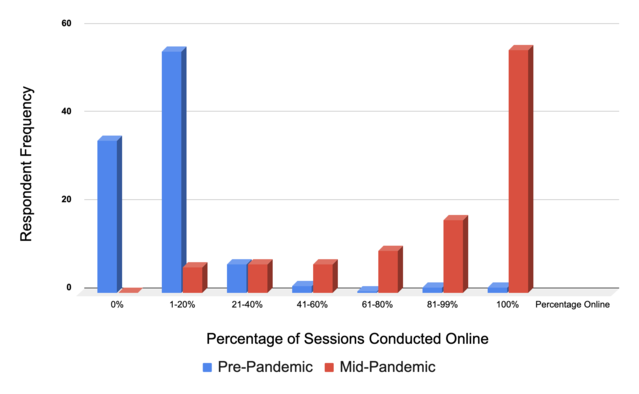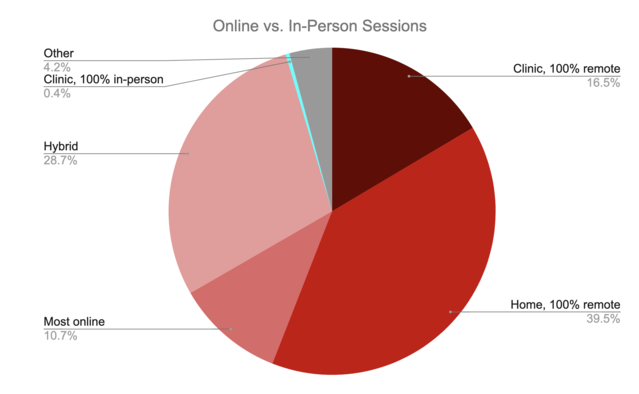Online Therapy
The Data Are In: Telehealth Is Here to Stay
For many psychoanalysts, the future will remain digital.
Posted November 10, 2021 Reviewed by Ekua Hagan
Key points
- Many therapists anticipate continuing to offer telehealth services after the pandemic.
- Online therapy requires standards comparable to those developed over many years for in-office practice.
- By working with insurance companies and state licensing boards, infrastructure to support therapists' shift to telehealth can be developed.
- Continuing education can help therapists shift to telehealth with the skill, integrity, and full knowledge of ethical practice.
Over the past few weeks, The COVID-19 Advisory Committee of the American Psychoanalytic Association, co-chaired by Todd Essig, Dan Prezant, and myself, conducted a survey to understand how our members are practicing now, how it was different from their practice before COVID, and what they anticipate as COVID either wanes or becomes the “new normal." The survey — designed and interpreted by Janine Wanlass, professor of counseling psychology at Westminster College in Salt Lake City — was distributed via email to 2,631 potential participants. The credit for this work is all hers.
We had 287 responses, including 268 from active clinicians, mostly practicing analysis at least some of the time and spanning the disciplines of psychiatry, psychology, social work, and allied mental health. The vast majority of our sample (97%) are in private practice, and about 74% of the respondents had been in practice for more than 20 years. It was an older group of respondents, with 85% over 50 years of age, including almost 40% of that group age 70 or older.
To provide a context for professional practice, we asked about current comfort with non-professional social exposure: social gatherings, movies, restaurants, plane or car travel. We learned that the comfort level was moderate in settings such as parks, outdoor restaurants, or small family and friend outdoor gatherings, but significantly lower in indoor settings such as movies, lectures, indoor dining, or airline travel. In their recreational lives, respondents seemed less eager to return to life as usual.
Technology Use, Before and After COVID
Before the pandemic, 35% had no use of technology in their practice, and another 55% used technology for less than 20% of their sessions. Only 10% were using technology regularly. Now, 55% are practicing only online, and more than another 25% are doing between 60-99% of their practice online. All of the respondents reported doing some form of online therapy; these numbers may include using the telephone, but we did not ask the respondents to differentiate between online or phone.
Slightly under 40% were doing some form of hybrid practice, with some patients online and at least one or more patients seen in-person in their offices. These numbers, overlaid on the graph below, show a decisive shift away from in-person sessions:

COVID Mitigation Measures in Therapeutic Spaces
We asked clinicians doing at least some in-person, in-office work (37% of private practitioners who responded to the survey) about requirements for their patients: 84% required complete vaccination, with another 4% allowing partial vaccination. Also, 66% were employing social distancing, and 36% were using masks. Only a small percentage were employing specialized informed consents related to COVID risks or contact tracing.

Future Plans and Expectations
This is respondents’ current practice status:

Note the vanishingly small blue sliver area that represents the practitioners who remain in their clinic and fully in person, working in the way that most of us did before the pandemic. These are the colleagues for whom 100% of their sessions are conducted in person from a clinic or commercial treatment space.
Moving Our Practice Into a Post-COVID Era
The implications for the future are telling: Only 9% of the respondents said they expected to return to an in-person, in-office setting full-time; 38% said they expected to be mostly in-person with telehealth when needed. Another 43% indicated they expected a combination of telehealth and in-person therapy. Only 5% said they expected to remain fully telehealth. Clinicians anticipate their patients wanting some mixture of telehealth and in-person treatment, and that only a few will choose either all online or only in-office therapy or analysis.
In short, we can expect a massive change in the way psychoanalysts manage their practices. (And although this was a survey of psychoanalysts, most analysts also do a great deal of psychotherapy; the implications are likely valid for analytic therapists, as well.) Distance vehicles for therapy and analysis are now almost universally expected to become a major — and, likely, dominant — method of clinical practice.
There are major implications for this shift, not the least being the challenges to be brought by state licensing boards that have traditionally made practice across state lines extremely difficult, and by insurance companies where policies have varied widely on reimbursement for telehealth. In many other countries, licensure is nationally recognized; practitioners do not face these challenges about the legalities of service delivery. I suspect the United States will be forced to adopt a similar legislative strategy.
But perhaps the largest problem facing us as therapists and analysts is the absence of comprehensive literature and research that would give us a knowledge base about competent practice in these modalities. We will need to know much more — about effective telehealth strategies, about standards of practice, about screen fatigue, and about our ability to act as effective therapists in this capacity — before we can guarantee a consistent standard of practice similar to that of the century-old practice of in-person therapy.
To find a therapist, please visit the Psychology Today Therapy Directory.
References
Alessandra Lemma (2017) The Digital Age on the Couch: Psychoanalytic Practice and New Media. New York and Abingdon, Oxon: Routledge.
Gillian Isaacs Russell (2015) Screen Relations: The Limits of Computer-Mediated Psychoanalysis and Psychotherapy. New York and Abingdon, Oxon: Routledge.
Jill Savege Scharff (2012). Clinical issues in analyses over the telephone and the internet (2012). International Journal of Psycho-Analysis, 93(1):81-95.
Jill Savege Scharff (2013). Technology assisted psychoanalysis (2013). Journal of the American Psychoanalytic Association, 61:491-509, 2013.
Jill Savege Scharff, editor. (2019) Psychoanalysis Online 4: Teleanalytic Practice, Teaching, and Clinical Research (2019) New York and Abingdon, Oxon: Routledge.




